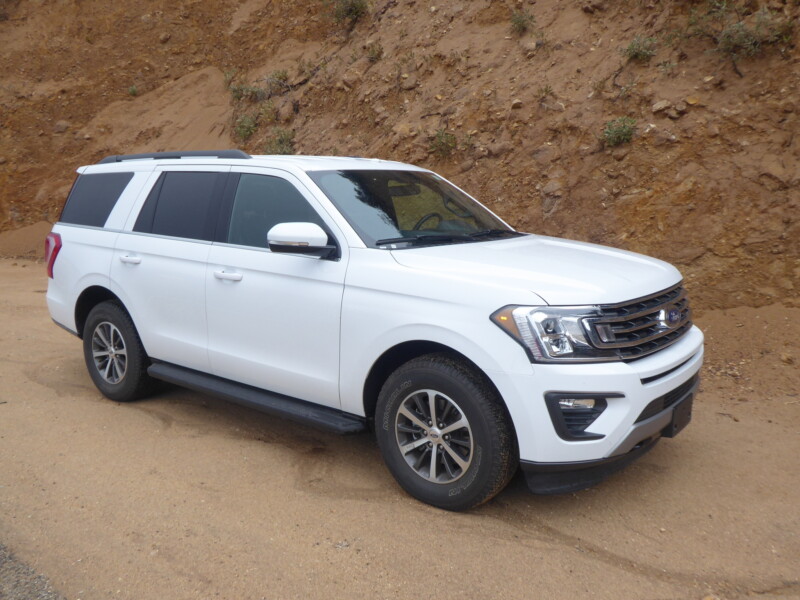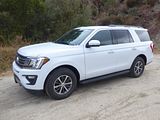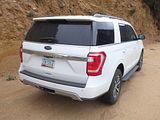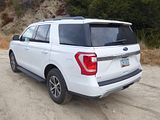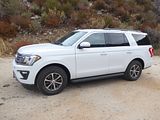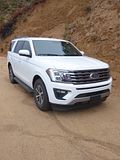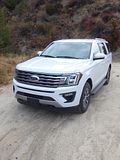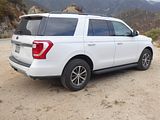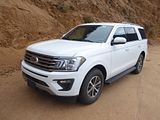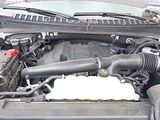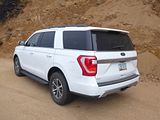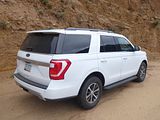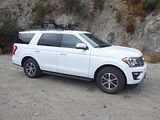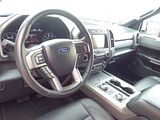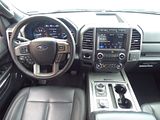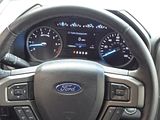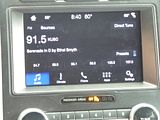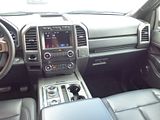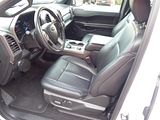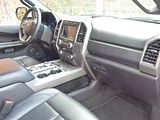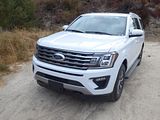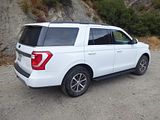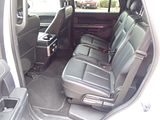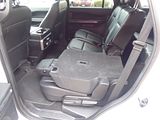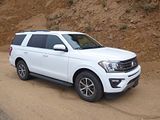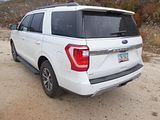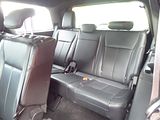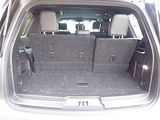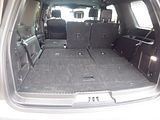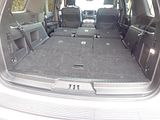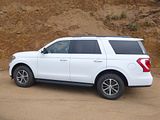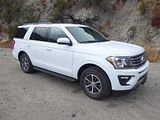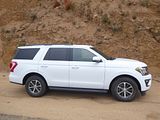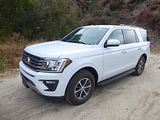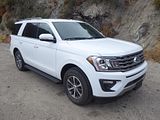There is a sizeable market in the US for massive SUVs, cars that will seat 7 or 8 people, carry a lot of luggage and also tow something hefty like a boat or a heavy trailer. Whilst Toyota and Nissan offer entrants in the class, with their Sequoia and Armada, respectively, the big sellers are the products from General Motors and the Ford Motor Company. In both case, these now long-running model series have their origins in their makers’ trucks, but over time they have gradually civilised (to an extent) the passenger carrying versions of the product, though they have still stopped short of the sort of changes that have been to vehicles one size smaller, which went from body on frame to unibody cars with independent suspension. Ford’s offering is called Expedition, and it has evolved in parallel with the best-selling vehicle in the US market, the F150 pickup. These days, though, it is far more than an F150 with side windows and seats and when the latest model was introduced, it diverged still further from the pickup family. The fourth generation of Expedition was unveiled on February 7, 2017, at the Dallas Cowboys training facility, Ford Center in Frisco, Texas, ahead of its Chicago Auto Show debut a few days later. Production started on September 25, 2017 with the first vehicles arriving at dealerships in November 2017. This really was an all-new product. It retained a body-on-frame (BOF) architecture with high-strength lightweight material construction consisting of boron steel and aluminium with the even larger body than what had gone before made from aluminium-alloy. The U553-generation Expedition moved to an all-new half-ton hydroformed T3 platform (chassis), which is a modified version of the half-ton platform underpinning the P552 2015 Ford F-150. Other changes included a new four-wheel independent suspension system design and there were updated powertrain systems (engines and transmissions) including a Hybrid variant with proprietary parallel hybrid electric-drive system to help increase fuel efficiency are expected and there was a new 10-speed 10R80 SelectShift automatic transmission. The latest safety systems and other equipment features were added. What did not change was the ability to accommodate 8 people and some luggage, but to accommodate it all, the body became even bulkier than before. Looks are always subjective, but I certainly did not find this new Expedition attractive, and there is no getting away from the act that it looks even bigger than ever before. Not only can I not reach the roof, I would struggle to get to anything other the bonnet. The 2018 models started to appear in the rental fleets during 2018 and early 2019 as the predecessor models reached the end of their time on fleet and there are now reasonable numbers of the available, so if you reserve a car of this size you are probably equally like to get a Chevy Tahoe or GMC Yukon (the main rivals) as a new Expedition. Having driven a Tahoe earlier in the year and not being totally convinced by some of its attributes, I wanted to try a new Expedition to see if it would please me more. My chance came on a day when the forecast – and the reality – was for a soggy sort of day towards the end of my November 2019 trip to LA when I found this 2019 model year example parked up in President’s Circle, so available for no upgrade fee. I grabbed at it and took it away for a day to see what I thought.
The engine in the latest Expedition is a revised version of the 3.5 litre turbo V6 Ecoboost which was fitted to later examples of the previous model. Installed here, it generates 375 bhp, plenty you might think but you have to remember that this is a massive vehicle and that it tips the scales at a minimum of 2545kg. It actually goes quite well, with more than sufficient acceleration to keep up with the traffic and an officially quoted 0 – 60 time of just 6.9 seconds which is good for a car of this size. Remember that this car is designed to handle not just 8 passengers with some luggage and potentially a hefty towed weight behind it, so one-up it is no surprise that it felt almost lively. It is smooth as well, with the 10 speed automatic gearbox moving between the ratios without you really realising it. Engine noise is well supressed and there was not much interference from road or wind sources, either, so this would be a quiet cruiser over a longer journey. Gone are the days when the maker of a car like this can ignore fuel economy, and indeed the reason why the engine for this generation has been downsized over previous Expeditions is to help in that regard, and it is also why you find a stop/start system. I covered 120 miles on a day where the weather was more like a late November British day than a Californian one, and needed to put 5.1 gallons on it to fill it up, which works out at 23.54 mpg US or 28.11 mpg Imperial, a decent result for such a gargantuan machine. And whilst it is big, it not as intimidating to drive as you might expect. You do sit much higher than other traffic and you have to remember that it is long and wide and take account of that especially when parking up and manoeuvering, but out on the road, it is surprisingly easy to drive. The steering is good, with ample feel, though it is light enough to make this massive Ford easy to position and the turning circle is tighter than you might expect for such a behemoth of a vehicle. The Expedition handles better than you might expect, though of course this is the very antithesis of a sports car and you do not throw it into the bends, not least as the centre of gravity is so much higher than on a smaller car. But it will go round the curvy roads that you find on the canyons where I took the car quite readily and even on a wet day there was ample grip that I could make decent progress. This version of the Expedition was on wheels that are smaller than you might expect: 275/65 R18. Sadly, the ride could be quite choppy at times, but on smooth surfaces it was better and there was none of the float you used to get from overly soft suspension. The test car had the optional AWD system which has shift-on-the-fly four-wheel drive selection, low-range gearing, a lockable rear differential, and nearly 10 inches of ground clearance all of which combine to give the Expedition old-school off-road potential, though this was not something I tested.The brakes have a tough job to do to stop a car of this weight, and I do wonder just how well they would fare when fully loaded. The pedal seemed a bit mushy but the car did come to a halt when I expected it to do so. There is an electronic handbrake with the button in the lower left of dash. All round visibility is mostly good, thanks in part to that commanding driving position and a good glass area, though the bonnet is massive and high, so you certainly can’t easily judge just where the front of the car is and there are also some thick side pillars which can you catch you out. There is a second piece of glass in the door mirrors to help to alleviate the blind spot and the rear-view camera helps to judge just where the back of the car is.
Although there are some Ford design cues inside the Expedition, the interior is much chunkier in appearance than in any of the smaller cars in the range having more in common with the Ford F-150 pickup. There are plenty of hard plastics here, but the quality seems reasonable enough, just not very premium in appearance or feel. There is a leather wrapped steering wheel and there are gunmetal effect inlays and chrome effect finishers to add some visual variety. There is keyless starting, with a button to the right of the wheel. There is a simple instrument cluster with two large round dials, for the speedometer and rev counter with four smaller ones set above which include the water temperature and fuel level. There are trip computer functions with various menus of options which you can cycle through with buttons on the wheel boss where you also find audio repeated and cruise control functions. There is just one column stalk, on the left of the wheel, with wipers operated by twisting the end, much as you get in Chrysler products. Lights operate from a rotary dial on the dash to the left of the wheel. The centre of the dash contains the integrated 8” colour touch screen which operates the My Ford Sync 3 system. This is something of an improvement on earlier systems and proved responsive enough and easy to use and there are still buttons to operate the audio functions that you can use rather than the screen itself. XM Satellite radio is included in XLT spec as are Android Auto and Apple car Play and the 6 speaker audio system proved perfectly acceptable. Beneath this are two rotary dials and a row of buttons for the three-zone climate control. There is a cylinder style gear selector in the centre console.
This is a big vehicle, set high off the ground, so getting in and out is not as easy as it is on a more moderately sized vehicle. Thankfully, there are running boards, which help with the big step up needed to clamber onboard, and these are also useful when getting out. Like many Ford Motor Company products there is a key pad on the B pillar, so you can get into a locked vehicle without needing a key as long as you know the access code. I do wonder how many people actually use this feature, but at least the numbers are quite well hidden these days. Once installed, I could survey the cavernous interior in which I was now sitting. Seat upholstery is all leather, not, it has to be said of the highest or softest quality. There is a full electric adjustment for the front seats including a lumbar support and with a telescoping wheel, I could easily get a good driving position. The seat is large and a bit shapeless but even so I found it comfortable enough to sit upon. For sure you are much higher than in a regular passenger car, which does give that oft-cited extra visibility over traffic, but despite this, and the sheer size of the passenger compartment, the Expedition did not feel as intimidating as I thought it might do.
The Expedition is a big car, with a long wheelbase even in standard form (there is an even longer one called Expedition Max is you need even more room) and that means that it really is realistic to think you could get 8 people in it. Getting in the back is like accessing the front – you will need those running boards. The doors open wide, which you will also need to remember if parked in a confined space, but provided you can open them fully, access is easy. There is lots of space for those in the middle row of seats, with ample legroom even if the front seats are set well back, and of course there is more headroom than even someone wearing a helmet would need and the width of the Expedition means three could easily sit comfortably here. The seats are split into three, with the middle part narrower than the outer ones and there are individually adjustable backrests and each seat cushion is on a slider so you can vary how far back they are positioned by a few inches. There is a drop-down armrest with cupholders in the upper surface and occupants here get their own climate controls, as well as map pockets on the back of the front seats and pockets on the doors for their odds and ends.
To gain access to the third row, you pull up and then push forward the middle row seat, which leaves a decent sized gap through which you need to scramble. Children will find it easy enough, but for adults it is all a bit undignified and requires a modicum of agility. Once installed, things all feel a bit tight. There was just enough headroom for me and legroom was sufficient, but those with longer legs than me mat find otherwise. The seat is set high enough that your knees are not in your chest as can be the case with some 7 seaters, but even so, these seats are really more suitable for children than adults. In the trim of the test vehicle, the tailgate is manually operated and since it is massive, it is also very heavy. There is not a lot of boot space when third row is erect, with the space quite deep but not that long front to back. There is a small stowage area under the boot floor. More space is created by dropping the rearmost row of seats, which are split 60/40. They are electrically raised and lowered which makes it very easy to put them up and down and once the third row is lowered, the there is a very sizeable luggage area which is flat, flush with the base of the tailgate. Even more space can be created by lowering the middle row of seats and again, these fold down so they are flush with the rest of the luggage area. Inside the cabin there is lots of space for odds and ends. There are two generous glove boxes, a huge and deep central cubby as well as a lidded area containing USB and 120V power outlets, bins on the doors and an oddments tray on the dash top as well as a useful recess on the passenger side of the centre console and a number of small areas for smaller items.
The 2019 Ford Expedition is available in three trim levels: XLT, Limited and Platinum. The XLT offers a balanced mix of comfort and utility, and plenty of available options, while the Limited introduces more premium elements. The top-trim Platinum loads on the luxury and comes with nearly every feature standard. An extended-wheelbase Expedition, which has a bigger cargo area, is called the Max. It’s available for the XLT and the Limited. The XLT starts with a turbocharged 3.5-litre V6 engine (375 bhp, 470 lb/ft of torque) paired to a 10-speed automatic transmission and a choice of rear-wheel or four-wheel drive. Standard equipment highlights include seating for eight passengers, 18-inch alloy wheels, running boards, roof rack rails, rear parking sensors, heated side mirrors, air conditioning, a power-adjustable driver’s seat, push-button ignition, a leather-wrapped steering wheel, a sliding and reclining 40/20/40-split second-row seat, and a 60/40-split fold-flat third-row seat. For technology, the XLT has an 8-inch touchscreen with Ford’s Sync 3 interface, Apple CarPlay and Android Auto smartphone integration, four USB ports (two in front and two in the second row), and a six-speaker sound system with satellite radio. The XLT offers two optional packages: 201A and 202A. The 201A package adds simulated leather upholstery for the first and second rows and a power-adjustable front passenger seat. More significantly, the 202A package builds on those items with a hands-free liftgate, keyless entry, remote engine start, power-folding mirrors, heated and ventilated front seats, driver-position memory settings, a power-adjustable heated steering wheel, power-adjustable pedals, dual-zone automatic climate control, ambient cabin lighting, a 110-volt household style outlet, blind-spot monitoring and rear cross-traffic alert. Stand-alone options include 20-inch wheels, roof rail crossbars, a panoramic sunroof, a navigation system, a heavy-duty trailer tow package, and a Driver Assistance package, which adds adaptive cruise control, lane keeping assist, forward collision warning with automatic emergency braking, automatic high beams and automatic wipers. An FX4 4×4 Off-Road package adds trail-ready components such as all-terrain tires, off-road shocks, low-range gearing, a 3.73 limited-slip rear axle and skid plates. The Limited trim bundles the features from the 202A package and adds 20-inch wheels, front parking sensors, retractable running boards, heated second-row seats, and a 12-speaker premium B&O Play sound system. Like the XLT, the Limited offers two optional packages, 301A and 302A. The former includes the panoramic sunroof, navigation and the driver assistance features listed above, while the latter tacks on 22-inch wheels, adaptive suspension dampers, LED headlights and foglights, a 360-degree view parking camera, and an automated parking system. Many of these features are available as stand-alone options, as are second-row leather captain’s chairs (which reduce seating capacity to seven) and a rear-seat entertainment system with dual headrest-mounted displays. The new-for-2019 Stealth Edition (303A) includes 22-inch black painted wheels, lots of gloss black exterior trim, and red interior stitching. Finally, the Platinum trim builds on the Limited and 302A features with interior wood accents, enhanced front seats with massage function, upgraded leather for the steering wheel, leather door trim and active noise cancellation. Options mirror those of the Limited. Notably, the Platinum also offers increased horsepower (400 bhp) and torque (480 lb/ft) when 93 octane fuel is used.
Was this a better car than the Tahoe? Yes, is the simple answer to that, and perhaps that is not a total surprise, as the Expedition is near the start of its model cycle whilst the Tahoe and its stablemates date from 2013 and are scheduled for replacement within the next year or so. You select a car like this for purely practical reasons, essentially because you have a need to carry a lot of people and/or luggage and may wish to tow something heavy. And when tasked with doing that, the Expedition would tick every proverbial box, as it is very spacious and practical. You don’t generally select a car like this because it would be good to drive, and whilst this is not a car for twisty roads, if you do find yourself on them, all is not lost, as the Expedition will acquit itself there better than you might expect. And its engine proved able to make the Expedition move more briskly than you would expect. It is these attributes where it really beats the GM offerings, at least for now. So if you really do need a vehicle as big as this, and there is a choice at the rental car counter, the Expedition is the one I would pick. But if you don’t need something this large, once the novelty has worn off, you will almost certainly think it is just too big and even for the wide-open spaces of America, you might just wish you’d taken something a little smaller. An Explorer or a Honda Pilot or one of the many other rivals in this class will be easier to manage, and park, less thirsty and that bit better to drive in every respect.

